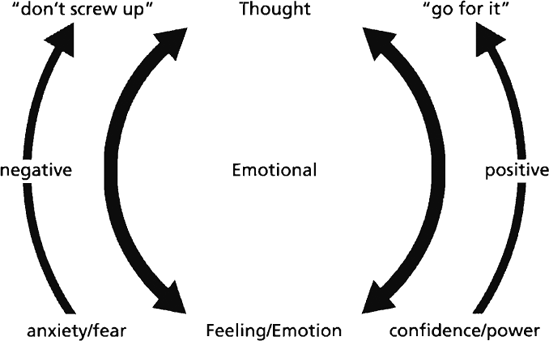Chapter 4. CHANGING CHANNELS
Thinking positively—especially under pressure—ean be achallenge. The way the human nervous system is wired, our emotions directly affect our thinking. Unless we develop the psychophysical control to manage our emotions, our ability to control our thoughts and images and ultimately our performance is limited.

Figure 4.1. Relationship Between Feelings/Emotions and Thoughts
Under the pressure to perform, to be the best we can be, our emotions are often charged with anxiety—feelings of tension, nervousness, a racmg heart, and shortness of breath. Anxious feelings cause tension and psycho-physical (mind-body) disintegration, which further increases feelings of pressure. Breaking the cycle involves learning to recognize those anxious feelings and being able to transform them into feelings of confidence, power, and ease. Then it's combining and supporting these emotions with power thoughts and high-performance imagery.
A favorite story of mine is about two Japanese monks. Passing through a village they were confronted by a beautiful young woman in a long silk kimono standing at the side of a muddy road. The young woman was afraid to cross for fear of getting her lovely kimono muddied. The first monk, seeing her dilemma, without hesitation walked over to her, picked her up, carried her across the muddy road, and set her down. The second monk was shocked. He stared ...
Get Performing Under Pressure: Gaining the Mental Edge in Business and Sport now with the O’Reilly learning platform.
O’Reilly members experience books, live events, courses curated by job role, and more from O’Reilly and nearly 200 top publishers.

